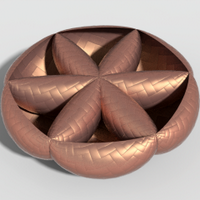
Geometry Collective
@geomcollective
We are a group of researchers @CarnegieMellon @SCSatCMU studying the interaction between geometry and computer science. (Threads & Insta: geometry.collective)
ID: 943108781491326977
http://geometry.cs.cmu.edu 19-12-2017 13:20:30
289 Tweet
3,3K Followers
12 Following



Super proud and excited for my student Zoë Marschner, who is one of only 18 recipients of the Fannie and John Hertz Foundation PhD fellowship! 🥳🎉🪅 Zoë has already done some top-notch work in geometry processing, which you can check out here: zoemarschner.com


One of my all-time favorite paper titles is "You Can Find Geodesic Paths in Triangle Meshes by Just Flipping Edges" by Nick Sharp and Keenan Crane. The entire core method of the paper is described fully by just the title! We need more papers like this. nmwsharp.com/research/flip-…

#geogram/Graphite and Nick Sharp's Polyscope play well together with Python ! Two Symposium on Geometry Processing award-winning softwares at your fingertips ! (cc Nicolò Campolongo : you need to import polyscope *before* gompy)


Very proud of my group Geometry Collective, for their consistent focus on quality in research. We have 5 papers at #SIGGRAPH2024, including two Best Paper Awards and one Honorable Mention. Only 5 and 12 such awards (respectively) are given out total, from a pool of ~840 submissions


Also proud of my student Mark Gillespie, who won *yet another* Best Paper (Honorable Mention) for very cool work on solid 3D knitting: markjgillespie.com/Research/solid… Altogether, this means Carnegie Mellon University Computer Graphics is taking home about 25% of all #SIGGRAPH2024 paper awards…!




For better or for worse, the Geometry Collective is now also on Threads as geometry.collective: threads.net/@geometry.coll…


The talk, slides, and code for our SGP graduate school course on MCGP can be found here: rohan-sawhney.github.io/mcgp-resources/ We cover a lot of ground: Monte Carlo integration, differential equations, Brownian motion, and of course walk on spheres, which nicely ties all these topics

A quick tutorial on polyscope in Python, in just a few tweets from Bruno Levy Bruno has been showing some great experiments this past week combining Polyscope with the excellent #geogram + Graphite, I love it!!

PSA: If you're making a poster for your #SIGGRAPH2024 talk, these are the dimensions (photo courtesy of Leona Caffey / ACM SIGGRAPH):


Need to solve PDEs, and struggle with meshing? Heard about "Walk on Spheres," but didn't know where to start? Check out the awesome intro course by Rohan Sawhney and @baileymmiller1, just posted from #SGP2024: youtube.com/watch?v=1u-5b4…









![Keenan Crane (@keenanisalive) on Twitter photo Signed distance functions (SDFs) are an important surface representation, which can be directly visualized via the “sphere tracing” algorithm.
At #SIGGRAPH2024 we showed how to sphere trace a whole new class of surfaces, based on *harmonic functions* rather than SDFs. [1/n] Signed distance functions (SDFs) are an important surface representation, which can be directly visualized via the “sphere tracing” algorithm.
At #SIGGRAPH2024 we showed how to sphere trace a whole new class of surfaces, based on *harmonic functions* rather than SDFs. [1/n]](https://pbs.twimg.com/media/GUneUpPXYAA8Nux.jpg)

